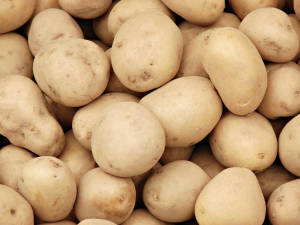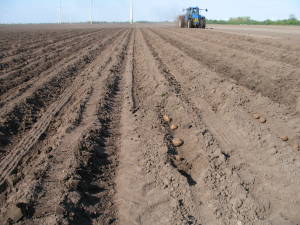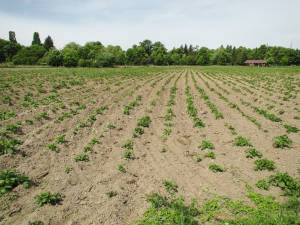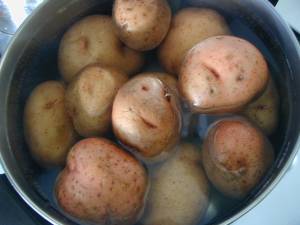The potato is almost a folk icon, having been a staple part of diets right across the world for millenia. It is a starchy carbohydrate that is versatile and delicious.
Unlike many other vegetables, growing potatoes at home doesn’t really improve the flavor when compared to varieties bought at the supermarket. Fresh veggies like tomato taste wonderful straight from the garden, but there is little difference in home grown potatoes and store bought ones. Commercial growers also have access to a wider range of varieties, including particularly flavorsome ones. Selection of potato seed is a more difficult process than selecting other seeds for vegetables as it’s imperative to get a good one. Be wary of unlabeled varieties.
Potatoes also take up a lot of space in the garden. They need quite a large amount of space between plants in order to grow to a decent size. Decide before planting whether it’s worth the space that they will take up. After all, potatoes are one of the cheaper vegetables to buy.
Varieties of Potatoes
Potatoes are available in a wide range of shapes and sizes. Once cooked there can be slight textural and taste differences between the varieties. There’s nothing worse than a mealy potato. Ensure that you get good quality seed potato, as potatoes are very prone to diseases. Buy from a nursery or a reputable grower.
Some examples of good potatoes to grow are below
- Winston
- Anya
- La Ratte d’Ardeche (or simply ‘Ratte’)
- Nicola
- Belle De Fontenay
- Spunta
How To Plant Potatoes
Potatoes are quite adaptable, which combined with their dense and filling nature, has made them a popular food the world over. Ideally, they are grown in cool climates. They do not tolerate frosts. Soil temperature should be greater than 7°C (45°F), so plant as soon as this occurs in your region. In many temperate regions this will be early spring. They can be grown in tropical climates but do not appreciate excessive rainfall, so plant in the dry season.
Potatoes are best grown from seed potatoes, which are small tubers that are designed to be disease free. They often need to be sprouted before planting in the ground. This is done by placing them in a tray in a light place (but not direct sunlight) for 2 or 3 weeks. The ‘eyes’ (little knobbly bits) of the potato will grow small shoots. Make sure that the seed potato sits in the tray or box with the highest number of eyes facing upright as possible.
Potatoes love lots of direct sunlight and rich, well-drained soil. They like a slightly acidic pH of between 5 and 6 in order to prevent fungal disease. Dig trenches 4-6 inches deep. Use a small amount of fertilizer at the base of the trench then back-fill with about an inch of soil.
If there are enough shoots on the potato, they can be cut up in to smaller sections before planting. You will need at least two or three shoots per potato section. Orient the seed potato in the trench so that there is at least one eye is facing upwards. Space the seed potatoes one foot (30cm) apart and leave 30-36 inches between rows (75-90cm). This is obviously quite a lot of space for the home garden and one of the things that should be considered before growing your own potatoes.
Growing Potatoes
Water regularly and keep weed free. Consistent watering is important. They rarely need much fertilizer – a good amount of sunlight is enough to sustain them.
As the plant grows, you will need to earth up around the potatoes to protect them from the sun. As previously mentioned, sunlight ‘greens’ potatoes which ruins their flavor. The earthing up process should begin when the plants are about 4 inches tall and continue every so often to ensure they are well covered.
See this article if you’re interested in growing potatoes in containers.
Harvesting Potatoes
Potatoes are a surprisingly fast growing vegetable, only taking around 14-20 weeks to mature depending on the variety. They grow faster in warmer weather. It’s a good idea to know what size to expect your potato to grow to so that you can harvest when they are full size. Check what size your particular variety grows to.
Potatoes can be stored and ‘hardened’ in the ground in preparation for storage. Simply let the plant die back and leave the potatoes in the ground for a further 2 weeks. Carefully lift the potatoes out of the ground with a fork after that. They can be stored in boxes or sacks in a cool, dry place. Exposing them to sunlight after harvesting causes greening of the skin, which ruins taste.
Some early varieties, or new potatoes, do not store well due to their thin skin. These potatoes are not fully mature when picked. They should be used fresh within a week, or can be blanched for 3 minutes and frozen in airtight bags.
It’s vital to eventually remove all the potatoes from the ground. Potatoes are particularly vulnerable to pests and diseases, and you don’t want any leftovers ruining the crop that will be planted in the soil next season.
Threats to Potatoes
Potatoes are prone to a variety of problems. In non-deal soil conditions, potato scab is common. It does not ruin the plant, and affected areas can be peeled off. Late blight turns potato leaves brownish and can spread to the whole plant. It is a fungal disease so treat with fungicide and avoid direct watering. Early blight looks similar but happens earlier and affects the lower leaves and tubers first.
On the virus front, leaf roll and mosaic viruses are the most common. Make sure to plant resistant varieties from seed potatoes rather than seeds. Bug threats include moths, caterpillars and beetles, amongst others. Remove manually or use an insecticide.




